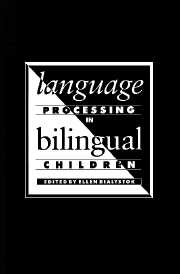Book contents
- Frontmatter
- Contents
- List of figures
- List of tables
- List of contributors
- Preface
- Introduction
- 1 Language modules and bilingual processing
- 2 Phonological processing in two languages
- 3 Second-language learning in children: a model of language learning in social context
- 4 Interdependence of first- and second-language proficiency in bilingual children
- 5 Giving formal definitions: a linguistic or metalinguistic skill?
- 6 Metalinguistic dimensions of bilingual language proficiency
- 7 Translation skill and metalinguistic awareness in bilinguals
- 8 Towards an explanatory model of the interaction between bilingualism and cognitive development
- 9 Constructive processes in bilingualism and their cognitive growth effects
- 10 Language, cognition, and education of bilingual children
- Index
2 - Phonological processing in two languages
Published online by Cambridge University Press: 11 January 2010
- Frontmatter
- Contents
- List of figures
- List of tables
- List of contributors
- Preface
- Introduction
- 1 Language modules and bilingual processing
- 2 Phonological processing in two languages
- 3 Second-language learning in children: a model of language learning in social context
- 4 Interdependence of first- and second-language proficiency in bilingual children
- 5 Giving formal definitions: a linguistic or metalinguistic skill?
- 6 Metalinguistic dimensions of bilingual language proficiency
- 7 Translation skill and metalinguistic awareness in bilinguals
- 8 Towards an explanatory model of the interaction between bilingualism and cognitive development
- 9 Constructive processes in bilingualism and their cognitive growth effects
- 10 Language, cognition, and education of bilingual children
- Index
Summary
Phonology is to a large extent the Cinderella of bilingual studies. The most immediately obvious aspect of speech is ironically that which has been least intensively researched with respect to bilingual speech behavior in general, and bilingual acquisition in particular. One reason for this may be its very peripherality in language processing. For the non-specialist, phonology is so predominantly concerned with the mechanics of language realization, so far removed from the broader psychological issues of cognitive development and processing, that it fails to grab the attention (even of the linguist who is a non-phonologist) in the same way as matters semantic, pragmatic, or even syntactic. These others may appeal as worthy of study not only in their own right, but also for their links with non-linguistic cognitive phenomena.
The subject of phonology is in itself so complex and ridden with controversy that it is difficult to know where to start to find a conceptual framework which will permit bilingual acquisition to be investigated. Even the analysis of the adult sound system of a single language involves a plethora of theoretical choices. Is the aim a taxonomic phonemic account, and if so how does one deal with any instances of neutralization or overlapping? Should one seek underlying forms, and, if so, how abstract should they be? What about suprasegmental phenomena — will one try to give a metrical account of rhythm, what about tones/intonation, how do these interact with segments? Are there segments? How many dimensions are there? What to do about feature geometry, etc? Each of these choices will fundamentally affect one's view of how phonology works, and therefore how it can be acquired.
- Type
- Chapter
- Information
- Language Processing in Bilingual Children , pp. 25 - 48Publisher: Cambridge University PressPrint publication year: 1991
- 28
- Cited by



